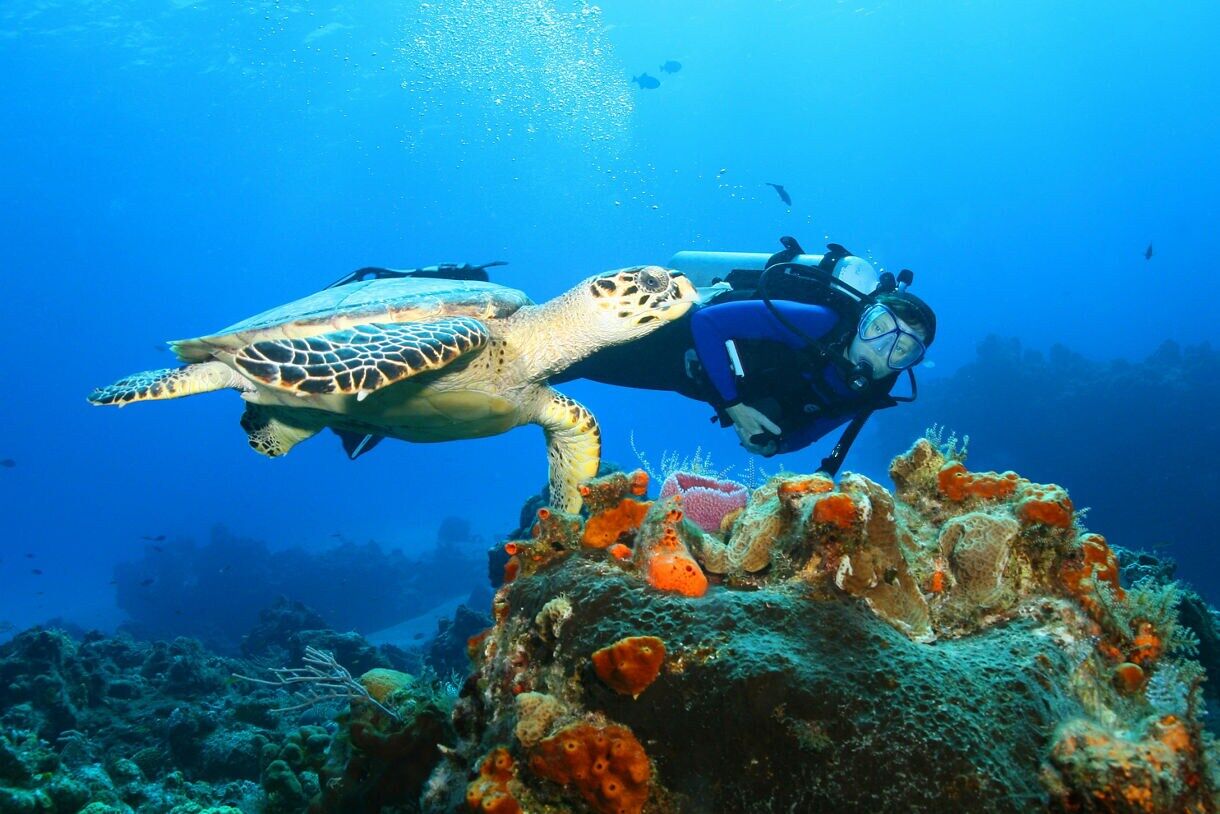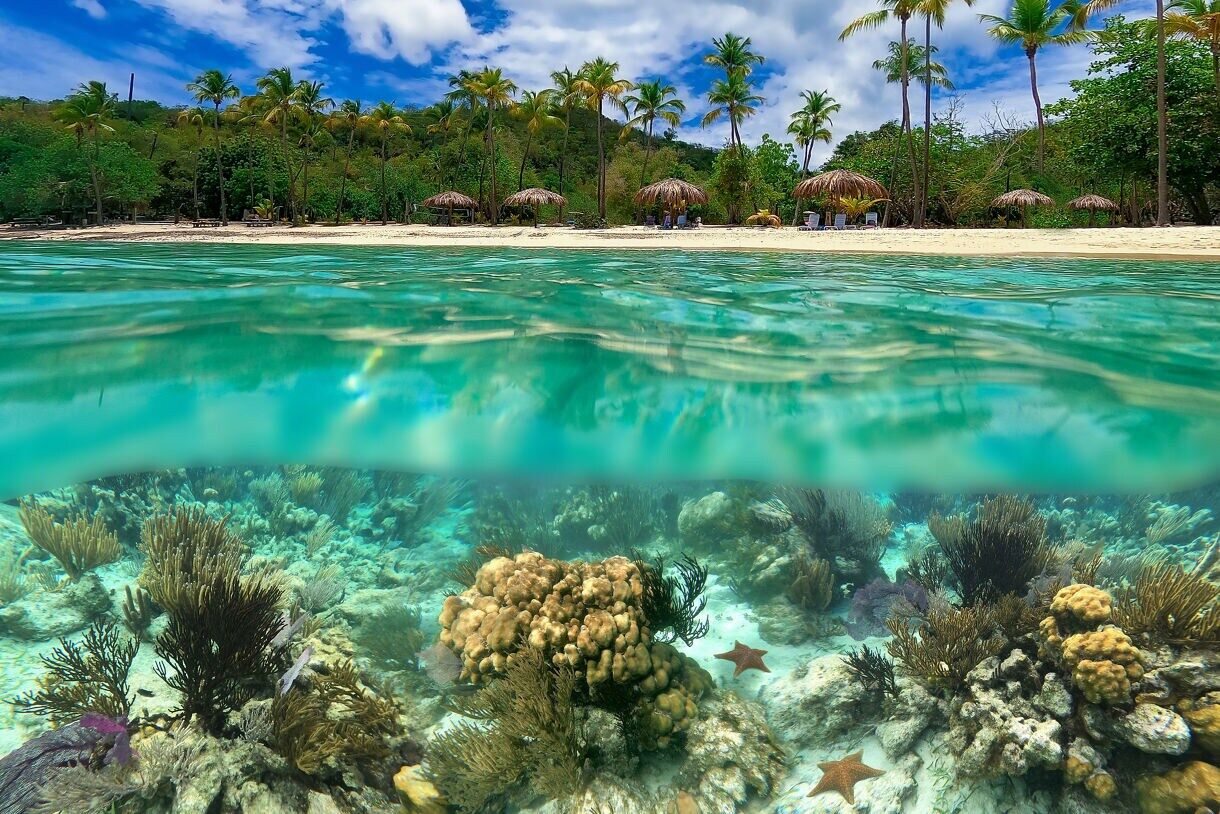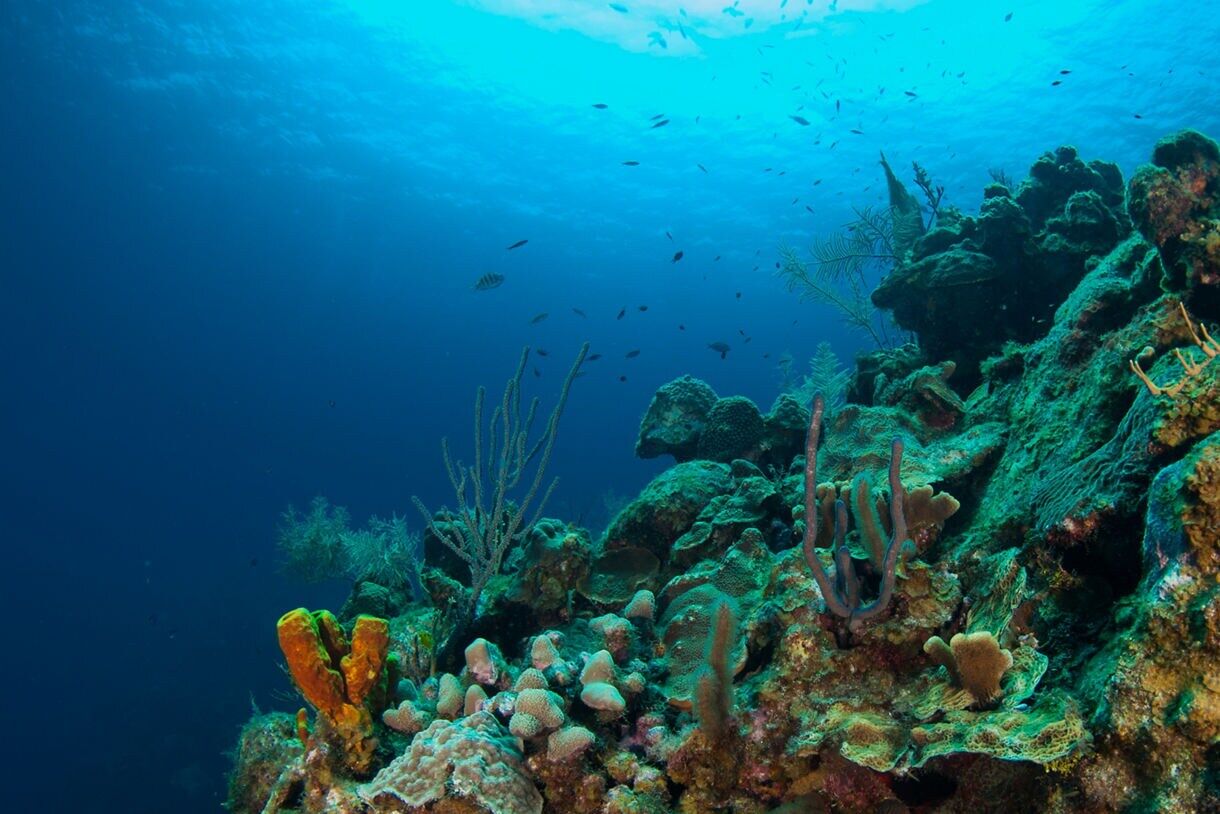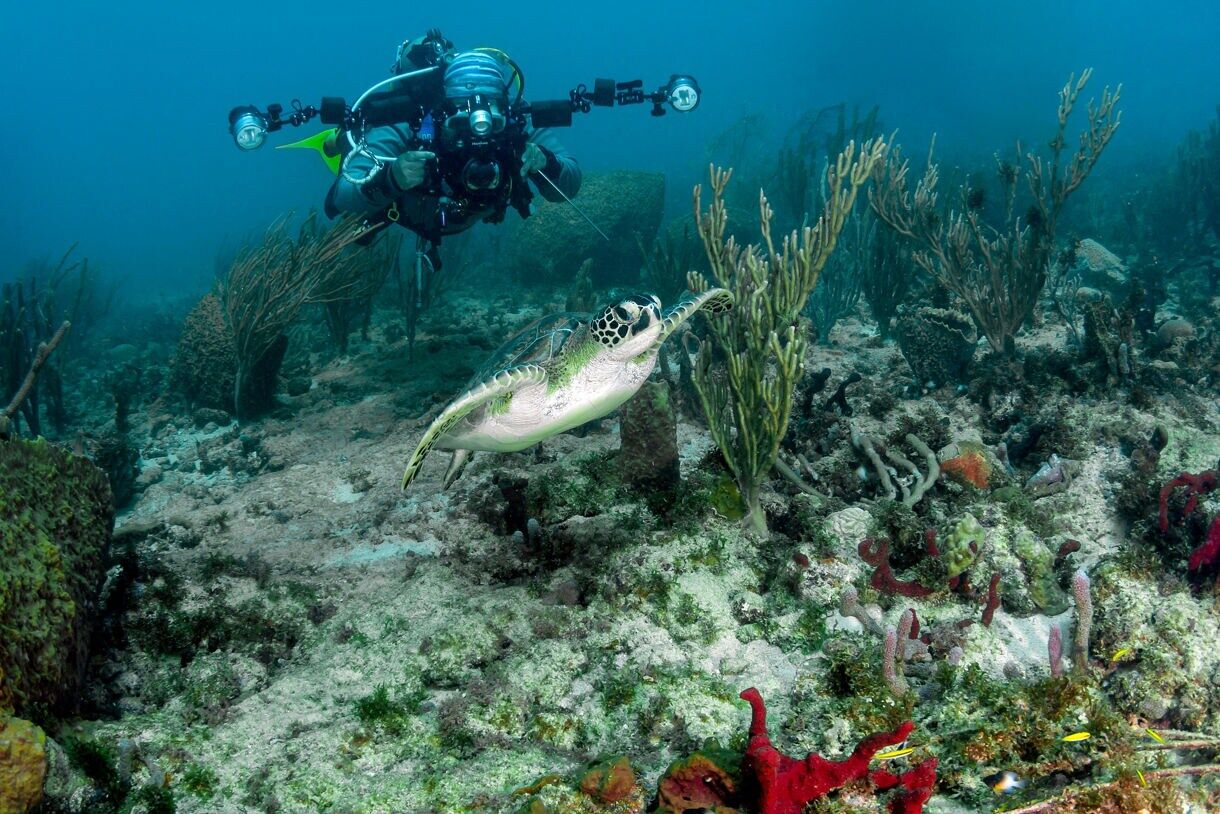
Swim alongside sea turtles in the warm, crystal-clear waters of the Caribbean — an unforgettable dive for ocean lovers.
Table of contents
Key takeaways
St. Thomas
Antigua
Grand Cayman
St. Kitts & Nevis
Start your Caribbean adventure
Grenada
Best time to dive in the Caribbean
Top tips for diving in the Caribbean
Plan your next diving adventure with Princess Cruises
If you’re looking for the best Caribbean diving, there’s no shortage of spectacular spots to explore. Coral gardens burst with color, dramatic shipwrecks stand frozen in time and marine life is so close you could almost high-five a sea turtle (we don’t recommend trying, but still). Princess Cruises® brings you closer to the best diving in the Caribbean with curated shore excursions and all the comforts you need after a day underwater.
With warm waters year-round, incredible visibility and a dazzling variety of reefs and wrecks, the Caribbean is a dream for divers of all skill levels. From beginner-friendly snorkeling gardens to heart-racing wall dives that plunge into the blue, every island offers something different — and something unforgettable.
- The Caribbean offers a wide range of dive experiences, from shallow coral gardens to thrilling wall dives
- Water temperatures stay between 78–84°F year-round, with visibility often reaching 100 feet or more in many destinations
- Booking a certified Princess scuba excursion means diving with local experts, access to top-tier equipment and effortless transport to world-class dive sites

Slip beneath the waves of St. Thomas and discover why it’s one of the Caribbean’s top diving playgrounds. Picture yourself weaving through underwater arches, gliding past vibrant coral reefs and spotting sea turtles coasting along like seasoned locals.
Dive sites like Cow and Calf Rocks are legendary, offering dramatic rock formations and swim-throughs teeming with tropical fish, while Sprat Point features a lively marine ecosystem packed with angelfish, parrotfish and even the occasional nurse shark cruising by.
Perfect for scuba-certified guests, the St. Thomas Certified Scuba Diving experience with Princess takes you to two of the best Caribbean diving locations, guided by local experts who know these waters like the back of their fins.
Expect warm water temperatures ranging from 79–84°F and visibility often reaching up to 100 feet (ideal for both seasoned divers and those just getting their feet wet). Diving in St. Thomas delivers a big adventure with island ease. You’re sure to capture photos of colorful reefs and curious sea turtles that will make your family jealous.
- Must-see marine moment: Watch for gentle sea turtles cruising through the swim-throughs at Cow and Calf Rocks — they’re practically locals here.

If you dream of diving where every turn reveals a new burst of color, Antigua is calling. This Caribbean gem is famous for its coral reefs, underwater cliffs and some of the warmest welcomes you’ll ever get — both above and below the waves.
Cades Reef is a must for beginner divers since it offers shallow, sun-drenched waters filled with swaying sponges, darting tropical fish and gentle nurse sharks. For more experienced divers craving a little adrenaline, Sunken Rock delivers with strong currents, deep walls and schools of eagle rays gliding by like something straight out of a nature documentary.
Antigua’s water temperatures hover between 78–84°F all year long, and visibility can stretch an impressive 140 feet in some spots. Basically, you’re getting the underwater equivalent of a five-star view. With dive sites scattered just a short boat ride from the cruise port, getting your fins wet here is as easy as it is unforgettable.
- Must-see marine moment: Keep your eyes peeled for eagle rays soaring like underwater birds around Sunken Rock.

When people talk about the best Caribbean diving, Grand Cayman always makes the list — and for good reason. This island isn’t just about world-class beaches and clear blue waters; it’s an underwater playground where every dive feels like stepping into another world.
The famous Cayman Wall offers one of the most dramatic drop-offs in the Caribbean, where you can drift along towering coral formations and spot turtles, reef sharks and massive barrel sponges. Scuba certified guests can explore this remarkable area on the Certified Scuba 2-Tank Diving of the West Wall excursion that is guided by local experts who know exactly where to find the marine action.
If you’re feeling social, head to Stingray City Sandbar — a surreal shallow dive where southern stingrays glide up to greet you like old friends. The Stingray Encounter, Reef, Snorkel & Scenic Cruise makes it easy to experience this one-of-a-kind spot, with plenty of time to snorkel among coral gardens as you interact with these gentle rays.
If you’re new to scuba, you can start with the Coral Gardens, a shallow snorkeling and diving haven where colorful reef life thrives. And when you’re ready to level up, try Babylon, a 100-foot wall dive packed with twisting coral towers and a rainbow of marine life.
Expect calm seas, year-round water temperatures between 78–82°F and visibility averaging 60–100 feet. These details make Grand Cayman a perfect recipe for unforgettable dives. Descend alongside a sheer cliff or hover above a sandy bottom filled with curious stingrays as Grand Cayman proves time and again why it’s a must-dive Caribbean destination.
- Must-see marine moment: Don’t miss the playful southern stingrays at Stingray City. They’re known for gliding right up to divers for a closer look.

For divers who enjoy a little history with their marine life, St. Kitts & Nevis delivers in spades. These twin islands offer the perfect blend of bright reefs and fascinating shipwrecks, each dive site telling its own story beneath the Caribbean Sea.
Start your underwater adventure at Monkey Shoals, a thriving reef where nurse sharks cruise lazily along coral gardens, lobsters peek out from rocky hideouts and colorful groupers hover like sentinels over the reef edge.
If you feel extra adventurous, the River Taw wreck (a freighter intentionally sunk in 1985) sits upright and invites divers to explore its coral-encrusted decks and interior chambers. It's a popular dive site for those who love the eerie, almost cinematic thrill of shipwreck diving.
Thanks to water temperatures consistently between 79–83°F and visibility that can stretch 60–100 feet, diving around St. Kitts & Nevis is both comfortable and unforgettable. This Caribbean destination is full of undersea surprises to take in as you glide along the reef or weave through a historic wreck.
- Must-see marine moment: See if you can spot nurse sharks napping under coral overhangs at Monkey Shoals — they're masters of camouflage.

Known as the "Shipwreck Capital of the Caribbean," Grenada is every diver’s dream if you love a little mystery with your marine life. The island is home to more than a dozen wrecks, each offering a different glimpse into the past. And none are more famous than the Bianca C. Nicknamed the "Titanic of the Caribbean," this 600-foot luxury liner rests elegantly on the ocean floor and promises a memorable deep dive surrounded by schools of jackfish and curious barracudas.
There are also options if you prefer something a little shallower. Explore the Shakem or the Veronica L., two smaller wrecks that are beautifully encrusted with corals and teeming with reef sharks, sea turtles and colorful marine creatures.
Grenada’s water stays invitingly warm at 78–82°F year-round, and visibility typically stretches 60–100 feet. You’ll find perfect conditions for both wreck and reef exploration. No matter if you’re descending into the depths of a historic ship or photographing a sea turtle gliding over a reef, diving in Grenada is nothing short of spectacular.
- Must-see marine moment: Snap a shot of the sea turtles floating effortlessly over the Bianca C shipwreck. It’s pure Caribbean magic.
One of the best things about diving in the Caribbean is that you can do it all year. With water temperatures hovering between 78–84°F and endless sunshine, every season feels like prime diving season. Calm seas and clear skies make December through May especially popular for divers, but even the summer months offer fantastic conditions. They just come with a few more afternoon rain showers (great excuse for a post-dive nap, honestly).
Shark and sea turtle migrations are most active in the winter months, offering incredible opportunities to spot these marine giants up close. To enjoy the best visibility, plan your dives around calm weather patterns, when the seas are glassy and the underwater world feels endless.
Are you looking to pair your dive days with a little extra beach time? Check out the best beaches in the Caribbean, each one perfect for relaxing between adventures. And if you're wondering when to book, our guide to the best time to visit the Caribbean has you covered.
Diving in the Caribbean is pure magic, but a little smart planning makes it even better. Here are a few quick tips to help you make the most of every dive.
- Dive with a buddy. Whether you're exploring a shallow reef or descending into a shipwreck, always dive with a partner. It’s safer, and honestly, it's way more fun when you have someone to share those sea turtle sightings with.
- Respect the reef. Coral reefs are living, breathing ecosystems. Avoid touching or standing on coral, and be careful with your fins near delicate marine life. A little distance helps protect the underwater world that makes Caribbean diving unmatched.
- Watch for currents. Some Caribbean dive sites — like the pinnacles off St. Kitts — can have strong currents. Always follow your guide’s instructions and be aware of your surroundings to enjoy a smooth, effortless dive.
- Choose certified dive excursions. Booking with Princess means you’ll dive with trusted local experts who prioritize safety and environmental protection. Plus, gear rental and transport to the best dive spots are included, which means you are free to focus on the real adventure.
- Stay curious. Every reef, wreck and wall has its own story. Take time to look closely — tiny seahorses, colorful nudibranchs and shy reef sharks are waiting to be discovered if you know where to look.